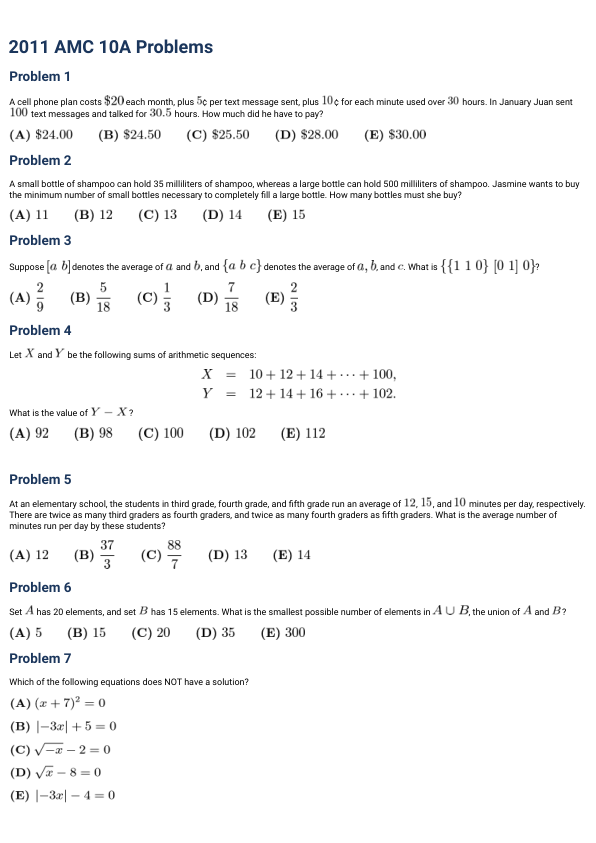2011 AMC amc10a 真题 答案 详解
| 序号 | 文件列表 | 说明 | ||
|---|---|---|---|---|
| 1 | 2011-amc10a-paper-eng-zh.pdf | 10 页 | 424.14KB | 中英双语真题 |
| 2 | 2011-amc10a-paper-eng.pdf | 4 页 | 153.35KB | 英文真题 |
| 3 | 2011-amc10a-key.pdf | 1 页 | 9.92KB | 真题答案 |
| 4 | 2011-amc10a-solution-eng.pdf | 16 页 | 1.28MB | 真题文字详解(英文) |
| 5 | 2011-amc10a-solution-eng-zh.pdf | 25 页 | 1.52MB | 真题文字详解(中英双语) |
中英双语真题
2011 AMC 10A
Problem 1
A cell phone plan costs $20 each month, plus 5¢ per text message sent, plus 10¢ for each minute used over 30 hours. In January Juan sent 100 text messages and talked for 30.5 hours. How much did he have to pay?
一种手机套餐每个月有 20 美元的固定费用。此外,每条短信收取 5 美分,语音通话超过 30 小时的部分,每分钟收取 10 美分。1 月份 Michelle 发送了 100 条短信,通话 30.5 小时。她需要支付多少美元?
(A) $24.00 (B) $24.50 (C) $25.50 (D) $28.00 (E) $30.00
Problem 2
A small bottle of shampoo can hold 35 milliliters of shampoo, whereas a large bottle can hold 500 milliliters of shampoo. Jasmine wants to buy the minimum number of small bottles necessary to completely fill a large bottle. How many bottles must she buy?
一小瓶可以装 35 毫升洗发水,而一大瓶可以装 500 毫升洗发水。Jasmine 想买最少数量的小瓶洗发水来装满一大瓶。她必须买多少小瓶?
(A) 11 (B) 12 (C) 13 (D) 14 (E) 15
Problem 3
Suppose [a b] denotes the average of a and b, and {a b c} denotes the average of a, b, and c. What is {{1 1 0}{0 1 0}}?
假设[a b]表示 a 和 b 的平均值,{a b c}表示 a, b, 和 c 的平均值。那么{{1 1 0}{0 1 0}}是多少?
(A) ( \frac{2}{9} ) (B) ( \frac{5}{18} ) (C) ( \frac{1}{3} ) (D) ( \frac{7}{18} ) (E) ( \frac{2}{3} )

英文真题
2011 AMC 10A Problems
Problem 1
A cell phone plan costs $20 each month, plus 5¢ per text message sent, plus 10¢ for each minute used over 30 hours. In January Juan sent 100 text messages and talked for 30.5 hours. How much did he have to pay?
(A) $24.00 (B) $24.50 (C) $25.50 (D) $28.00 (E) $30.00
Problem 2
A small bottle of shampoo can hold 35 milliliters of shampoo, whereas a large bottle can hold 500 milliliters of shampoo. Jasmine wants to buy the minimum number of small bottles necessary to completely fill a large bottle. How many bottles must she buy?
(A) 11 (B) 12 (C) 13 (D) 14 (E) 15
Problem 3
Suppose [a b] denotes the average of a and b, and {a b c} denotes the average of a, b, and c. What is {{1 1 0} {0 1 0}}?
(A) ( \frac{2}{9} ) (B) ( \frac{5}{18} ) (C) ( \frac{1}{3} ) (D) ( \frac{7}{18} ) (E) ( \frac{2}{3} )
Problem 4
Let X and Y be the following sums of arithmetic sequences:
(X = 10 + 12 + 14 + \cdots + 100),
(Y = 12 + 14 + 16 + \cdots + 102).
What is the value of Y - X?
(A) 92 (B) 98 (C) 100 (D) 102 (E) 112
Problem 5
At an elementary school, the students in third grade, fourth grade, and fifth grade run an average of 12, 15, and 10 minutes per day, respectively. There are twice as many third graders as fourth graders, and twice as many fourth graders as fifth graders. What is the average number of minutes run per day by these students?
(A) 12 (B) ( \frac{37}{3} ) (C) ( \frac{88}{7} ) (D) 13 (E) 14
Problem 6
Set A has 20 elements, and set B has 15 elements. What is the smallest possible number of elements in A ∪ B, the union of A and B?
(A) 5 (B) 15 (C) 20 (D) 35 (E) 300
Problem 7
Which of the following equations does NOT have a solution?
(A) ( (x+7)^2 = 0 )
(B) ( |-3x| + 5 = 0 )
(C) ( \sqrt{-x-2} = 0 )
(D) ( \sqrt{x}-8 = 0 )
(E) ( |-3x|-4 = 0 )

真题文字详解(英文)
Problem 1
A cell phone plan costs $20$ dollars each month, plus $5$ cents per text message sent, plus $10$ cents for each minute used over $30$ hours. In January Michelle sent $100$ text messages and talked for $30.5$ hours. How much did she have to pay?
(A) $24.00$ (B) $24.50$ (C) $25.50$ (D) $28.00$ (E) $30.00$
Solution
The base price of Michelle's cell phone plan is $20$ dollars. If she sent $100$ text messages and it costs $5$ cents per text, then she must have spent $500$ cents for texting, or $5$ dollars. She talked for $30.5$ hours, but $30.5 - 30$ will give us the amount of time exceeded past $30$ hours. $30.5 - 30 = .5$ hours $= 30$ minutes. Since the price for phone calls is $10$ cents per minute, the additional amount Michelle has to pay for phone calls is $30 * 10 = 300$ cents, or $3$ dollars. Adding $20 + 5 + 3$ dollars $[28 \text{ (D)}]$
Problem 2
A small bottle of shampoo can hold $35$ milliliters of shampoo, whereas a large bottle can hold $500$ milliliters of shampoo. Jasmine wants to buy the minimum number of small bottles necessary to completely fill a large bottle. How many bottles must she buy?
(A) $11$ (B) $12$ (C) $13$ (D) $14$ (E) $15$
Solution 1
To find how many small bottles we need, we can simply divide $500$ by $35$. This simplifies to $\frac{100}{7} = 14\frac{2}{7}$. Since the answer must be an integer greater than $14$, we have to round up to $15$ bottles, or [E]
Solution 2
We double $35$ to get $70$. We see that $70 \cdot 7 = 490$, which is very close to $500$. Thus, $2 \cdot 7 + 1 = (E)15$ bottles are enough. ~Technodoggo
Problem 3
Suppose $[a \ b]$ denotes the average of $a$ and $b$, and $(a \ b \ c)$ denotes the average of $a$, $b$, and $c$. What is ${(1 \ 1 \ 0) \ (0 \ 1 \ 0)}$?
(A) $\frac{2}{9}$ (B) $\frac{5}{18}$ (C) $\frac{1}{3}$ (D) $\frac{7}{18}$ (E) $\frac{2}{3}$
Solution
Average $1$, $1$, and $0$ to get $\frac{2}{3}$. Average $0$, and $1$, to get $\frac{1}{2}$. Average $\frac{2}{3}, \frac{1}{2}$, and $0$, to get (D) $\frac{7}{18}$
Problem 4
Let X and Y be the following sums of arithmetic sequences:
$$X = 10 + 12 + 14 + \cdots + 100,$$
$$Y = 12 + 14 + 16 + \cdots + 102.$$
What is the value of $Y - X$?
(A) $92$ (B) $98$ (C) $100$ (D) $102$ (E) $112$
Solution 1
We see that both sequences have equal numbers of terms, so reformat the sequence to look like:
$$Y = 12 + 14 + \cdots + 100 + 102$$
$$X = 10 + 12 + 14 + \cdots + 100$$
From here it is obvious that $Y - X = 102 - 10 = 92$ (A)
Note
Another way to see this is to let the sum $12 + 14 + 16 + \ldots + 100 = x$. So, the sequences become
$$X = 10 + x$$
$$Y = x + 102$$
Like before, the difference between the two sequences is $Y - X = 102 - 12 = 92.$
Solution 2
We see that every number in Y's sequence is two more than every corresponding number in X's sequence. Since there are $46$ numbers in each sequence, the difference must be $46 \cdot 2 = 92$

真题文字详解(中英双语)
Problem 1 A cell phone plan costs $20$ dollars each month, plus $5$ cents per text message sent, plus $10$ cents for each minute used over $30$ hours. In January Michelle sent $100$ text messages and talked for $30.5$ hours. How much did she have to pay? 一个手机套餐每月费用为 $20$ 美元,每发送一条短信需支付 $5$ 分钱,超过 $30$ 小时的使用时间还需支付每分钟 $10$ 分钱。一月份,Michelle 发送了 $100$ 条短信,通话时长为 $30.5$ 小时。她需要支付多少钱?
(A) $24.00$ (B) $24.50$ (C) $25.50$ (D) $28.00$ (E) $30.00$
Solution The base price of Michelle's cell phone plan is $20$ dollars. If she sent $100$ text messages and it costs $5$ cents per text, then she must have spent $500$ cents for texting, or $5$ dollars. She talked for $30.5$ hours, but $30.5 - 30$ will give us the amount of time exceeded past $30$ hours. $30.5 - 30 = .5$ hours $= 30$ minutes. Since the price for phone calls is $10$ cents per minute, the additional amount Michelle has to pay for phone calls is $30 * 10 = 300$ cents, or $3$ dollars. Adding $20 + 5 + 3$ dollars $[28 \text{ (D)}]$ Michelle的手机套餐基础价格为 $20$ 美元。如果她发送了 $100$ 条短信,每条短信费用为 $5$ 分钱,那么她必须花费 $500$ 分钱用于短信,或 $5$ 美元。她通话时长为 $30.5$ 小时,但 $30.5 - 30$ 将告诉我们超出 $30$ 小时的使用时长。$30.5 - 30 = .5$ 小时 $= 30$ 分钟。由于电话费是每分钟 $10$ 分钱,Michelle 需要额外支付的电话费用为 $30 * 10 = 300$ 分钱,或 $3$ 美元。加上 $20 + 5 + 3$ 美元 $[28 \text{ (D)}]$。
Problem 2 A small bottle of shampoo can hold $35$ milliliters of shampoo, whereas a large bottle can hold $500$ milliliters of shampoo. Jasmine wants to buy the minimum number of small bottles necessary to completely fill a large bottle. How many bottles must she buy? 一小瓶洗发水可以容纳 $35$ 毫升洗发水,而一大瓶可以容纳 $500$ 毫升洗发水。Jasmine 想购买刚好能装满一大瓶洗发水的小瓶的最少数量。她需要购买多少瓶?
(A) $11$ (B) $12$ (C) $13$ (D) $14$ (E) $15$
Solution 1 To find how many small bottles we need, we can simply divide $500$ by $35$. This simplifies to $\frac{100}{7} = 14\frac{2}{7}$. Since the answer must be an integer greater than $14$, we have to round up to $15$ bottles, or [E]. 要找出需要多少小瓶,我们只需将 $500$ 除以 $35$。这简化为 $\frac{100}{7} = 14\frac{2}{7}$。由于答案必须是大于 $14$ 的整数,我们必须向上取整到 $15$ 瓶,或 [E]。
Solution 2 We double $35$ to get $70$. We see that $70 \cdot 7 = 490$, which is very close to $500$. Thus, $2 \cdot 7 + 1 = (E)15$ bottles are enough. ~ Technodoggo 我们将 $35$ 加倍得到 $70$。我们看到 $70 \cdot 7 = 490$,非常接近 $500$。因此,$2 \cdot 7 + 1 = (E)15$ 个瓶子就足够了。~ Technodoggo
Problem 3 Suppose $[a b]$ denotes the average of $a$ and $b$, and $(a b c)$ denotes the average of $a$, $b$, and $c$. What is ${(1 1 0)[0 1 0]}$? 假设 $[a b]$ 表示 $a$ 和 $b$ 的平均值,$(a b c)$ 表示 $a$、$b$ 和 $c$

